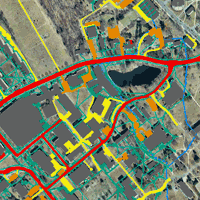
3 Reasons why an IC-TMDL may make your life easier
Your work life, that is. (Sorry to say, an IC-TMDL will have little effect on your obnoxious boss or irritating in-laws). Responding to any water regulation is a challenge, but the impervious cover approach gives you several advantages over more traditional methods. Below are three main reasons why. And if you don’t feel like reading, watch our award-winning explanatory video below.
1. The concept is easy to understand.
You don’t have to be a PhD in water chemistry and aquatic biology—or hire one—to understand the issue. The goal of reducing runoff from paved surfaces is a lot simpler to grasp than, for instance, reducing milligrams per liter of nitrogen or colonies of bacteria per 100 milliliters. Therefore, as you develop and implement your response plan, it will be more easily understood by the various key players in the land use development process: planners, commission members, developers, land owners, and the public.
2. Impervious surfaces comprise an identifiable, tangible “pollutant.”
Unlike chemical or biological water constituents, impervious cover is pretty easy to identify. It’s safe to say that we all know what a parking lot looks like. This tends to make IC easier to locate, measure, map, and track—tasks essential to responding to a TMDL.
3. IC is (mostly) under your control.
With the major exception of state and federal highways, impervious cover is generated by your local land use regulations and the way they dictate how your town is developed. This makes it easier to identify changes in plans, regulations and procedures that need to be made in order to minimize impacts from future development.
Why an IC-TMDL May Make Your Life Easier Video


